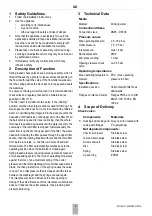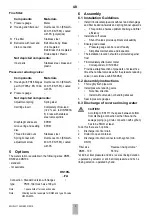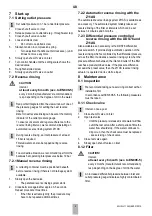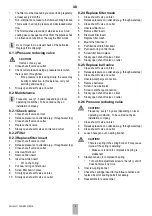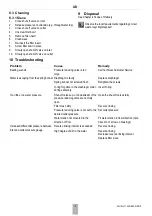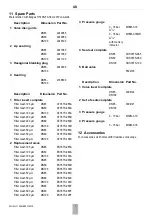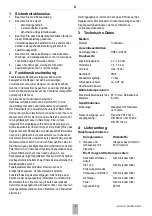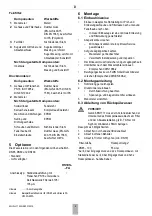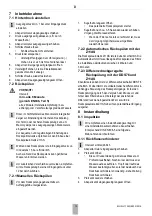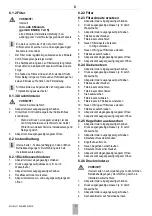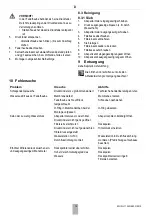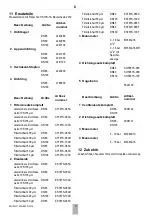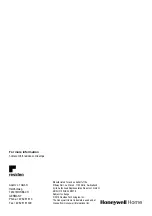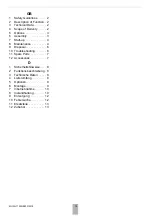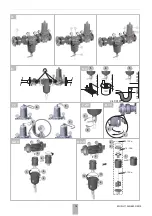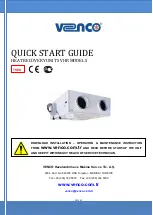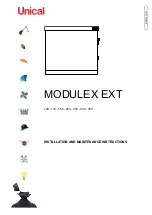
GB
2
MU0H-1155GE23 R0319
1
Safety Guidelines
1.
Follow the installation instructions.
2.
Use the appliance
•
according to its intended use
•
in good condition
•
with due regard to safety and risk of danger.
3.
Note that the appliance is exclusively for use in the
applications detailed in these installation instructions.
Any other use will not be considered to comply with
requirements and would invalidate the warranty.
4.
Please take note that any assembly, commissioning,
servicing and adjustment work may only be carried out
by authorized persons.
5.
Immediately rectify any malfunctions which may
influence safety.
2
Description of Function
Spring loaded check valves have a moving seal disc which is
lifted off the seat by a greater or lesser amount depending on
the flow rate through the valve. If the flow falls towards zero,
then the spring pushes the disc back onto the seat and seals
the waterway.
To ensure continuing correct function it is recommended that
check valves be regularly checked and maintained (as
specified in EN 1717).
The filter insert is divided into two parts. In the „filtering“
position, only the lower, larger section is used for filtering. The
small upper section does not come in contact with unfiltered
water. An oscillating flap integrated in the sieve prevents the
deposition of dirt particles on the upper part of the filter. When
the ball valve is opened for reverse rinsing, then the whole
filter insert is pushed downwards until the water supply to the
outer side of the main filter is stopped. Simultaneously, the
water flow is opened to the upper part of the filter. The water
needed for cleaning the filter passes through the upper filter
section, then the rotating impeller with jets and the main filter
from inside to outside, i.e. the filter is reverse rinsed with
filtered water. The filter automatically switches back to the
operating position when the ball valve is closed again.
Spring loaded pressure reducing valves operate by means of
a force equalising system. The force of a diaphragm operates
against the force of an adjustment spring. If the outlet
pressure and therefore diaphragm force fall because water is
drawn, the then greater force of the spring causes the valve
to open. The outlet pressure then increases until the forces
between the diaphragm and the spring are equal again.
The inlet pressure has no influence in either opening or
closing of the valve. Because of this, inlet pressure fluctuation
does not influence the outlet pressure, thus providing inlet
pressure balancing.
3
Technical Data
4
Scope of Delivery
Check valve:
Media
Medium: Drinking
water
Connections/Sizes
Connection sizes:
DN65 - DN100
Pressure values
Max. operating pressure:
2.0 - 16.0 bar
Outlet pressure:
1.5 - 7.5 bar
Inlet pressure:
max. 16 bar
Nominal pressure:
PN16
Min. pressure drop:
1.0 bar
Opening pressure check
valve:
ca. 0.05 bar
Operating temperatures
Max. operating temperature
medium:
65°C (max. operating
pressure 6.0 bar)
Specifications
Installation position:
Horizontal with filter bowl
downwards
Flanges on inlet and outlet: Flanges PN16 acc. to DIN
86021 / ISO 7005-2, EN
1092-2
Components
Materials
1
Housing and housing end
casing with flanges
Grey cast iron coated with
PA (polyamide)
Not depicted components:
Check valve insert
Stainless steel
Test and drain plugs
Stainless steel
Screws and nuts
Stainless steel
Disc
Stainless steel
Spring
Stainless steel
Lip seal ring
EPDM


